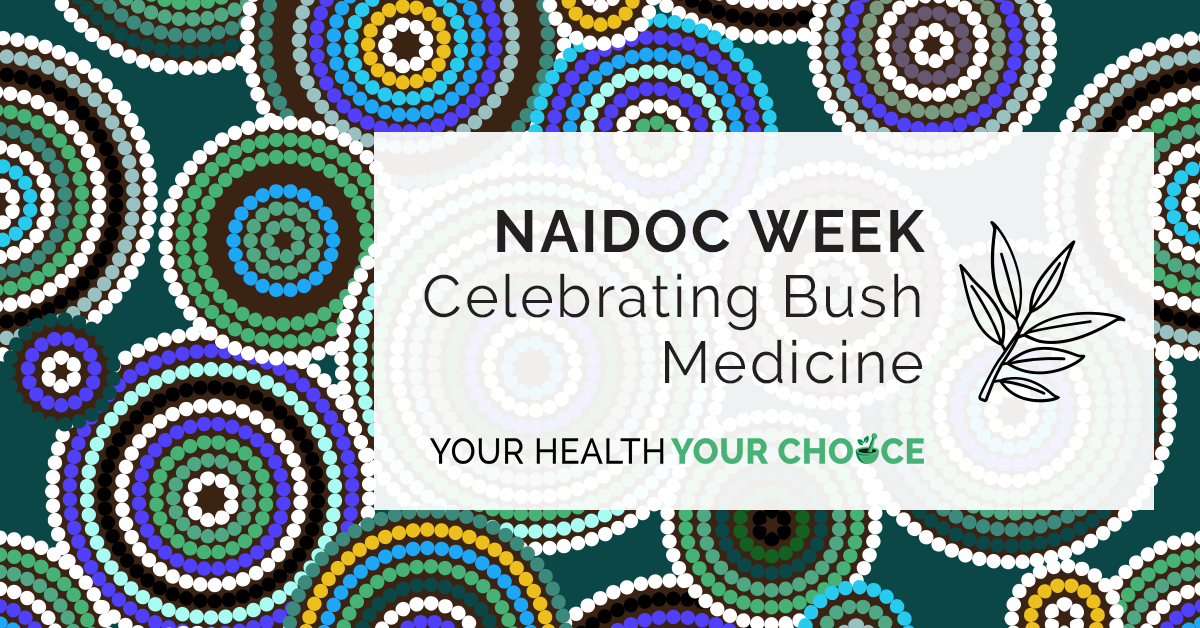Celebrating Bush Medicine – NAIDOC week

NAIDOC Week is an opportunity to celebrate not only Indigenous achievement but the history, rich culture, and survival of the oldest continuing living culture on the planet. Bush medicine has been integral to Australian Aborigines and Torres Strait Islanders culturally and spiritually for millennia, drawing on the resources of the environment for medicines.
The practice of bush medicine within Australia is at risk of being lost due to the impact of colonisation and ongoing loss of culture.1 Thankfully, there are initiatives in various parts of the nation that are breathing new life into the practice of traditional healing. This article respectfully acknowledges the wisdom and connection of Aboriginal and Torres Strait Islander cultures as we take a look at some of the more commonly used bush medicines.
Bush Medicine – not just healing the sick
Indigenous healing programs have a two-prong benefit of helping the sick while also being a conduit for intergenerational learning and strengthening of the community.
Cultivation of medicinal plants may also offer a financial enterprise for some indigenous groups such as the Akeyulerre healing centre in Alice Springs, established by Arrernte elders, as a place to practice and enjoy their cultural life on a daily basis and producing traditional medicines as rubs, soaps and other products. Both older and younger Arrernte women harvest the plants and make the products. By carrying on this culture, the women can begin their own healing journeys.2
The Ngangkari from South Australia have been doing important work alongside biomedical doctors in treating Indigenous patients. One four-year research project found the following benefits to providing a ‘holistic two-way health care model’:
- – a broader view of a patient’s condition
- – a lesser chance of misdiagnosis
- – better patient experiences
- – a greater compliance rate with Western biomedical treatments.3
Interestingly, many Ngangkari do not treat conditions such as drug addiction or diabetes, as these are illnesses resulting from colonisation. They have no Indigenous cultural basis to treat from.4
“I realise all this sounds very different to all you doctors and nurses who worked so hard at university to get where you are today. You have studied so many books. But we are working towards the same goal of healing sick people and making them feel better in themselves, as you are. In that way we are equal.” Andy Tjilari, Ngangkari, Central Australia
Other traditional ventures are growing in strength in other regions of the country also.
What is Bush Medicine?
“Bush medicine is a way of life. It comes from the land and we come from the land.” Akeyulerre Chairwoman, Tisha Carter.
The role of a traditional healer within Indigenous culture is highly regarded. Often healers are identified at birth. Traditional healers will address mental, spiritual or physical ills by using bush medicine, healing songs, or touch to heal spirit and mind.
Bush medicine is using native barks, food, seeds and leaves as remedies. Most of this lore is passed down through stories and singing or dancing ceremonies. Bush medicine is made and applied in a variety of ways. It can be crushed, heated, boiled, smoked, inhaled and applied to directly to the skin.
Common Indigenous Bush Medicines
Gumbi Gumbi (Pittosprum angustifolium) is used in significant number of traditional medicinal applications, from the treatment of coughs and colds to eczema, and even used for lactagogue (milk let-down) activity. Recent research into the benefits of Gumbi Gumbi find it to boast an array of benefits including, being an anti-pruritic, anti-viral, detoxifier, blood pressure regulator and immune system booster.5
Lemon grasses (Cymbopogon ambiguus A. Camus) can be liquefied and drunk to treat diarrhoea, and coughs, sore throats and colds. It can also be applied to the skin for treatment of rashes and sores, and a root poultice mixture can be applied to ears for earaches.
Emu Bush (Eremophila longifolia) both medicinal and ceremonial purposes. The leaves have been used as a decoction, for sores and wounds; an infusion for colds, headaches, chest pains and diarrhea treatment and smoked to create a sterile environment for newborn babies and healing new mothers.
Goat’s Foot (Ipomoea pes-caprae) used to treat stings. Plant leaves are crushed, heated and apply directly to the skin.
Old Man’s Weed (Centipeda cunninghamii) to sooth the symptoms of arthritis and for a strong immune system.
Kangaroo Apple (Solanum laciniatum) used to treat swollen joints. The fruit is a natural anti-inflammatory.
Billy Goat Plum/Kakadu Plum (Terminalia ferdinandiana) the Indigenous answer to the common cold. The fruit contains 50 times more vitamin C than an orange.
Eucalyptus leaves were boiled to create an oil to treat bruises and cuts or infused and inhaled to help alleviate symptoms of asthma, body aches, chills and fever. The treated bark soothed inflamed limbs.
Snake Vine (Hibbertia scandens) were warmed and mashed into a paste and used as a topical application for pain of arthritis for joints and other inflammation from injuries. The sap was also used as a broad-spectrum antiseptic.
Tea Tree oil (Melaleuca teretifolia Endl) the paper bark leaves are ground into a paste and applied to wounds and fungal infections. It is also brewed into tea for sore throats and relieve colds. The leaves and bark of tea tree were crushed, and the vapour inhaled to treat headaches.
Umbrella Bush Wattle (Acacia ligulata Benth) soaked the bark in water or boiled it and the decoction was used as a cough medicine for sore throats and a remedy for dizziness and nerves/anxiety. People in the Western Australian region would also char the shrub and mix the ash with a native tobacco (Pituri) for chewing to relieve sore gums.
Tree sap can be used as a semi-sweet treat that made a good chewing gum substitute and a binding agent for wounds.
Witchetty grubs (E. leucomochla) are used as a treatment of burns and open wounds, after being crushed and made into a paste and then sealed to help the skin heal.
Always was, always will be
Like all medicines, bush medicines should be taken with supervision by skilled healers/professionals. Contributing to the demand for bush medicines will continue to benefit communities who harvest these natural wonders. The cultural significance alone is remarkable, creating a significant bedrock for stronger independence and self-sufficiency amongst these communities.
It would be a travesty to our nation if the ancient traditions of Indigenous healing were lost. Australia could benefit by looking to other nations to improve support for more integration between Indigenous and biomedical medicines, like what we are seeing in South Australia with the Ngnagkari, which in turn will greatly enhance cultural connection and healing.
Beautifully, Indigenous medicine encompasses a holistic worldview which reflects that of the World Health Organizations definition of health, which is one of ‘physical, mental and social wellbeing and not merely the absence of disease or infirmity’.3
- https://healthinfonet.ecu.edu.au/learn/cultural-ways/traditional-healing-and-medicine/#aihref1
- https://www.abc.net.au/news/2019-09-28/bush-medicine-keeping-womens-culture-alive-and-well/11545810
- https://www.ncbi.nlm.nih.gov/pmc/articles/PMC3702459/
- https://www.gptq.qld.edu.au/discover-indigenous-health/traditional-medicine/
- https://www.gumbi-gumbi.com.au/research
« Return to News & Features
